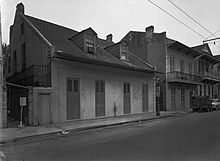Creole architecture in the United States

Creole architecture in the United Statesis present in buildings in Louisiana and elsewhere in the South, and also in the U.S. associated territories ofPuerto Ricoand theU.S. Virgin Islands.A variant isPonce Creolestyle.
| This article is part of a series on the |
| Culture of Louisiana |
|---|
 |
| Society |
| Arts and literature |
| Other |
| Symbols |
|
Louisiana portal |
Creole cottages
[edit]In the U.S. south, acreole cottageis a type ofvernacular architectureindigenous to theGulf Coast of the United States.The style was a dominant house type along the central Gulf Coast from about 1790 to 1840 in the former settlements ofFrench LouisianainAlabama,Louisiana,andMississippi.The style is popularly thought to have evolved fromFrenchandSpanishcolonial house forms, although historians are uncertain about its origins.
Creole architecture in Louisiana is documented by numerous listings in the U.S.National Register of Historic Places.[1]
The "Creole cottage" type of house was common along the Gulf Coast and associated rivers in the 19th century with a few scattered examples found as far west asHouston,Texas,and as far east as northernFlorida,although the majority of structures are found in southern Louisiana eastward toMobile, Alabama.[2]In Kentucky, a few scattered cottages still stand in the state's far westernJackson Purchaseregion, where they continued to be built into the early twentieth century.[3]
Architectural features
[edit]
Two features of this style of house are thought to be influences from other places in France's former colonial empire. The full frontporchis believed to originate from theCaribbeanislands, while the high gabled roof, the ridge of which is parallel to the street, accommodating the porch as well as the mass of the house, is thought to be ofFrench-Canadianorigin.[4]In the earlier or more fundamental examples one or two main rooms may open directly onto the porch. They often feature an interior chimney that pierces the ridge line of the roof, with back-to-back fireplaces serving two rooms. Two common secondary characteristics of this style are a raised basement and the frequent situating of the front of the buildings at the property line.[4]
In the city of New Orleans, the termCreole cottagetends to be more narrowly defined as a1+1⁄2-story house with a gabled roof, the ridge of which is parallel to the street. The house normally has four squarish rooms with no hallways and is built up to the front property line. The primary difference between these cottages and those elsewhere is the lack of a full front porch.[5]
A similar house type that some architectural scholars believe is related to the Creole cottage is the Gulf Coast cottage. However, it is not clear if this type is derived from the Creole cottage or if it is aDeep Southadaptation of aTidewater-type cottage.They both display some of the general characteristics of a Creole cottage. In the more formal and later examples, a central hall is almost always present. These more formal examples began to appear in the 1820s and 1830s. They are typically larger withFederalorGreek Revivalarchitectural influences not present in the simpler version. If a central hall is present, then usually it is entered via a central entrance. End-gable chimneys are often present rather than a central one.[4]
Puerto Rico and U.S. Virgin Islands
[edit]Ponce Creole,centered inPoncein southernPuerto Rico,is a distinctive high style reflected in many standing buildings.
An earlier, less formal style, with perhaps less surviving presence, is a "Spanish-Creole" style of which theJuana Rodríguez Morales HouseinCayeyis an example.
See also
[edit]References
[edit]- ^Jay Edwards (Spring 1990)."National Register of Historic Places Multiple Property Documentation: Louisiana's French Creole Architecture"(PDF).National Park Service.Archived fromthe original(PDF)on October 7, 2016.RetrievedDecember 8,2016.
Creole architecture is a distinctive building tradition associated with American tropical and subtropical environments. For our purposes, the typical Creole house can be described as follows. Its most important features include 1) generous galleries or verandas, 2) a broad spreading roofline, 3) gallery roofs supported by lightweight wooden colonnettes, 4) placement of the principal rooms well above grade, (sometimes a full story above the ground), 5) the use of a form of construction utilizing a heavy timber frame combined with an infill made of brick (briquette entre poteaux) or a mixture of mud and moss called bousillage, 6) multiple French doors, and 7) French wraparound mantels. Creole architecture is also characterized by certain geometric conventions. These include the characteristic system of establishing the floorplan, which consists of a central core of a few rooms and various optional ancillary spaces which encircle the central core. This gives the Creole house a tradition of expanding outward in all directions.
- ^Gamble, RobertHistoric architecture in Alabama: a guide to styles and types, 1810-1930,page 180. Tuscaloosa, Alabama: The University of Alabama Press, 1990.ISBN0-8173-1134-3.
- ^Macintire, William J.National Register of Historic Places Inventory/Nomination: George Stone House.National Park Service,1993-02-16, 9.
- ^abcGamble, RobertHistoric architecture in Alabama: a guide to styles and types, 1810-1930,pages 37-41. Tuscaloosa, Alabama: The University of Alabama Press, 1990.ISBN0-8173-1134-3.
- ^"Creole Cottage".Architectural Patrimony.Archived fromthe originalon September 5, 2007.Retrieved2008-02-12.
